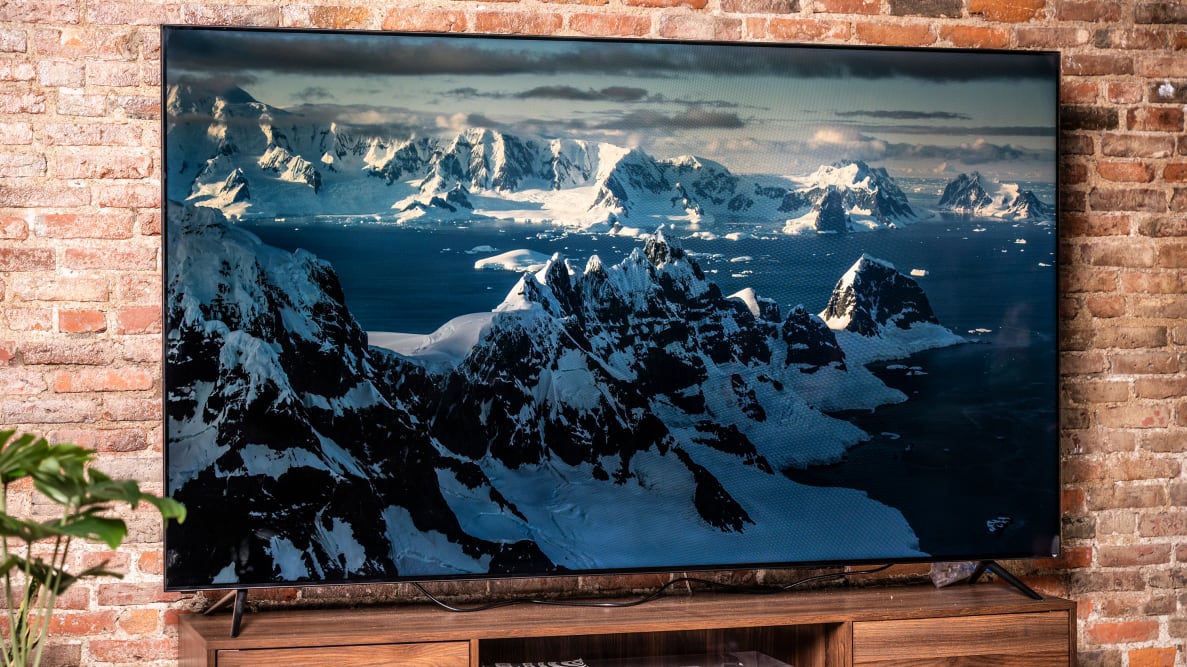Pros
-
Incredibly bright
-
Great way to showcase HDR
-
Great for next-gen gaming
Cons
-
Lifted black levels
-
Poor off-axis performance
-
Would benefit from a calibration
In many ways, the P-Series Quantum X (PQX) succeeds: Its picture quality, particularly in HDR, is great. It’s one of the brightest TVs we’ve ever tested and holds up beautifully in bright, sunny rooms. It offers enough in the way of next-gen gaming features for it to make a great gaming TV.
Unfortunately, the high-octane brightness of the PQX’s full-array LED panel lifts black levels during bright scenes. There’s also a considerable amount of light bloom, especially when viewed from off-axis positions. Vizio’s built-in smart platform, while improved this year, is still nowhere near as flexible as some of its competitors.
What you’re left with is a TV that’s a decent fit for a very narrow segment of shoppers. Folks spending this amount of money on an 85-inch TV would probably rather spend more on a TV that performs better, and folks who want a more affordable 85-inch TV will likely spend far less than the PQX’s asking price.
About the Vizio P-Series Quantum X
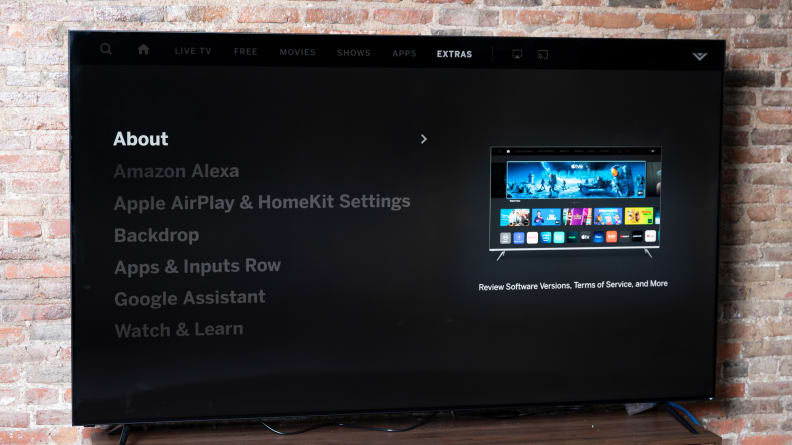
The Vizio PQX's full-array local dimming has 792 dimming zones.
The P-Series Quantum X is available in just one screen size: 85 inches. We received our review unit on loan from Vizio.
- 85-inch (Vizio P85QX-J01), MSRP $3,299.99
Like the previous version of the P-Series Quantum X, this year’s 85-inch model is reported to have 792 total LED zones.
With pricing out of the way, let’s take a look at the PQX’s specs:
- Resolution: 4K (3,840 x 2,160)
- Display type: Full-array local dimming with quantum dots (VA-style panel)
- HDR support: Dolby Vision, HDR10, HDR10+, HLG
- Dolby Atmos: Yes (native decoding)
- eARC support: Yes
- Native refresh rate: 120Hz
- Smart platform: SmartCast
- Color: DCI-P3 color space/10-bit chroma resolution
- Variable Refresh Rate (VRR): Yes
- Auto Low Latency Mode (ALLM): Yes
- Processor: IQ Ultra
- Other features: ProGaming Engine, FreeSync Premium, Google Chromecast, Google Assistant, Alexa, Apple AirPlay 2, Apple HomeKit
The Vizio P-Series ships with the newest version of Vizio’s remote control, which offers dedicated app buttons and a built-in microphone for voice recognition.
Connectivity
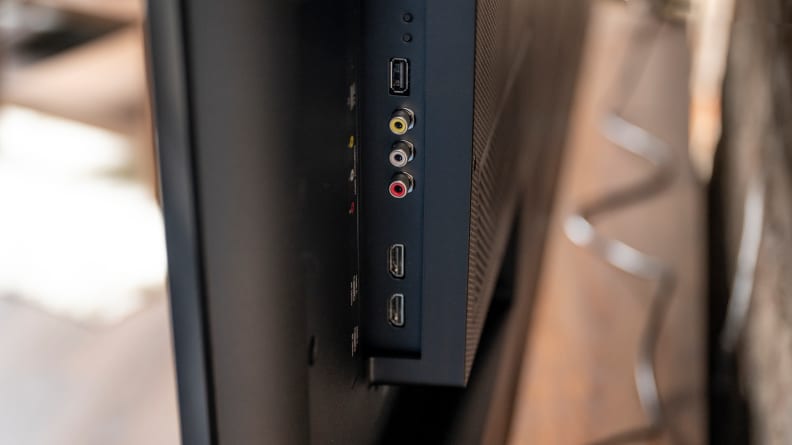
The PQX has four HDMI ports, two of which are HDMI 2.1 and support 4K/120Hz gaming.
Gamers and A/V enthusiasts will be pleased to note that the PQX features four HDMI 2.1 ports. However, only two of them are capable of displaying a 4K signal at 120Hz. The designated ARC/eARC port is one of the 4K/60Hz ports.
Here’s what you’ll find on the back of the TV’s massive, 85-inch panel:
- 4x HDMI 2.1 (2x 4K @ 120Hz, 2x 4K @ 60 Hz, 1x HDMI ARC/eARC)
- 1x USB 2.0
- RF connection (cable/antenna)
- Ethernet (LAN) input
- Digital audio output (optical)
- Analog audio output
Performance data
Before testing each TV, we make sure the panel is on and receiving a continuous signal for at least 24 hours, allowing the pixels plenty of time to warm up. Our P-Series Quantum X received this standard warm-up time before any readings were taken. In addition, the TV received the latest firmware updates at the time of testing.
For both SDR and HDR tests, we’re using the PQX’s Calibrated Dark picture mode. We’ve chosen this setting because of its accuracy, but performance may vary depending on which picture mode is enabled. For example, you might experience a brighter picture with different settings enabled, but it may interfere with color temperature and overall color accuracy.
For additional context, I also conducted both SDR and HDR tests in the TV’s Calibrated and Bright picture modes, but these test results are not reported below.
To get a sense for the TV’s average performance, we use a standard ANSI checkerboard pattern for most of our basic contrast tests. We also use white and black windows ranging from 2% to 90% to test how well the contrast holds up while displaying varying degrees of brightness.
Our peak brightness measurements are taken with sustained windows to represent the TV’s peak brightness over a sustained period of time. Specular highlights (like brief flashes of reflected light) might reach higher brightness levels, but not for sustained periods of time.
All of our tests are created with a Murideo Seven 8K signal generator and tabulated via Portrait Displays’ Calman Ultimate color calibration software.
I'll expand on our test results throughout the review, but for now, here are some key takeaways:
HDR contrast (brightness/black level): 770 nits/0.179 nits (ANSI checkerboard) SDR contrast (brightness/black level): 223.4 nits/0.063 nits (ANSI checkerboard) HDR peak brightness (sustained): 2,877 nits (10% white window) HDR color gamut coverage (DCI-P3/10-bit): 94% SDR color gamut coverage (Rec.709): 99%
For all tests, the PQX’s Ambient Light Sensor was disabled, the Color Temperature was set to Warm, and the Gamma was fixed at 2.2. During SDR tests, the TV’s Backlight setting was kept at its default (30).
In addition, for both HDR and SDR tests, Black Detail, Edge Enhancement, Local Contrast, and Film Mode were all disabled. The TV’s Active Full Array setting was set to High.
What we like
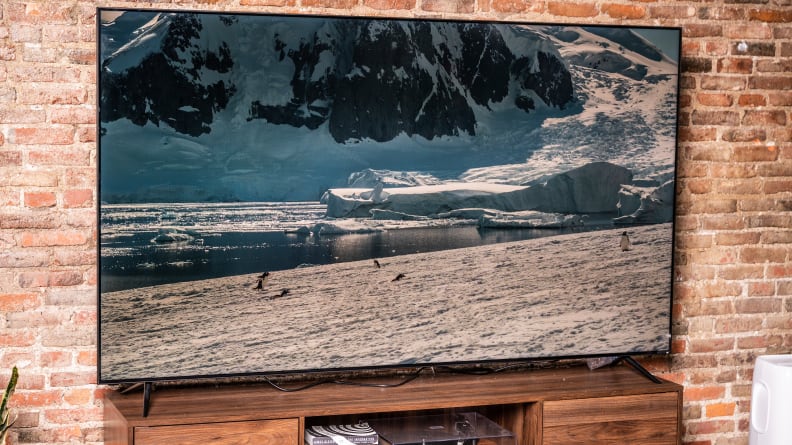
The Vizio PQX is only available as an 85-inch model, and it's the brightest TV we've seen this year.
The brightest TV we’ve seen all year
The first thing you’ll likely notice upon turning on this TV for the first time is its searing brightness. I’ve tested a number of brighter-than-average TVs this year, and so far, the PQX outpaces them all—even the Neo QLED flagship from Samsung, the QN90B can’t quite reach those figures.
While it can be misleading to focus on peak brightness numbers and nothing else, the level of luminance on display here is quite impressive. Most content (like cable TV shows, over-the-air broadcasts, and the majority of streaming titles) are mastered for Standard Dynamic Range (SDR). While receiving an SDR signal, the PQX is capable of pushing highlights well over 900 nits. When brighter picture elements take up most of the screen, this number drops significantly. Nevertheless, the PQX is brighter in SDR than most—especially mid-range TVs with less-premium display hardware. If you do a fair amount of casual viewing during the day, you needn’t worry about the PQX wilting in a sunny room.
Content mastered for High Dynamic Range (HDR) (high-profile streaming titles, UHD Blu-rays, and next-gen video games) is even brighter on the PQX. In its most-accurate, dark-room picture mode (Calibrated Dark), the TV is capable of producing highlights in the 2,500- to 3,000-nit range. When brighter elements make up most of the picture, this number settles into the 700- to 900-nit range.
The combination of ample full-field brightness and searing, intense highlights makes HDR content the PQX’s bread and butter.
HDR is bright and colorful
Whether you pop in an HDR-mastered Blu-ray or stream a Dolby Vision title via Netflix, you’ll be gifted a bright, colorful picture worthy of an eyeball feast. The PQX may have some serious flaws (which I’ll get into shortly), but watching HDR content on it feels like a premium experience, and that’s precisely how HDR content is supposed to feel.
Thanks in part to the TV’s quantum-dot display, colors on the PQX look rich and lively—especially greens, which are almost too saturated. The PQX covers 94% of the HDR color space (DCI-P3), and all of those hues really benefit from the TV’s scorching brightness.
As mentioned, the TV’s ability to push specular highlights up into the 2,000- to 3,000-nit range makes all of the difference in HDR. Small, concentrated areas of intense brightness (like explosions and reflections of sunlight) are dazzling on the PQX, and it’s part of the reason why this TV is such an exceptional pairing for HDR content, even if your living room gets a daily dose of sunlight.
An excellent big-screen TV for next-gen gaming
It’d be a shame if a TV as big, bright, and HDR-capable as this didn’t offer satisfactory next-gen gaming support. Fortunately, the PQX has gamers covered. Two of its four HDMI 2.1 ports are ready to tackle 4K gaming at 120 frames per second, whether you own an Xbox Series X, a PlayStation 5, or both.
The PQX also supports both Variable Refresh Rate (VRR) and Auto Low Latency (ALLM, two sought-after gaming features that improve how games are rendered and played. VRR eliminates screen-tearing by ensuring that all of the action on your TV screen is in sync with the video information being output by your next-gen gaming console. ALLM lets the PQX automatically switch into a low-latency game mode whenever a console is detected.
The PQX doesn’t offer a dedicated gaming hub (like LG’s Game Optimizer or Samsung’s Game Bar), nor does it support 4K/120Hz gaming on all four HDMI 2.1 ports. However, it offers enough upside for gamers that it can truly be called a gamer-friendly TV. At this size and price, that’s a good thing.
What we don’t like
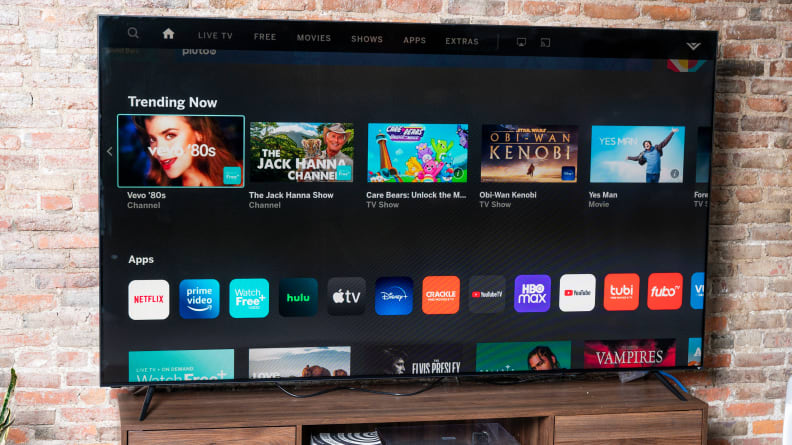
Vizio's SmartCast OS is faster than previous years, but you're still limited to the pre-installed apps.
Brighter content lifts the black levels
The Vizio PQX’s full-array display features 792 LED zones; this is a pretty high number, even for an 85-inch TV. These zones do a pretty decent job of keeping its black levels low when there are only small areas of concentrated light. With a more evenly balanced image however, the TV’s local dimming struggles to maintain those black levels. In other words, most of the time, the TV’s black levels aren’t that impressive—especially when it’s delivering a bright, HDR picture.
To illustrate what I mean: On the PQX, a small, white box surrounded by black looks pretty good. In HDR, that white box will produce a brightness level of around 2,800 nits, while the black region surrounding the box will stay in the 0.05- to 0.08-nit range. This is quite good. The box is more than bright enough to stand out, and the surrounding darkness maintains its inky appeal.
When an equal amount of white and black boxes are displayed across the screen, however, the story’s different. Suddenly, areas of total blackness become less inky. In one instance, I measured a black level of 0.179 nits when such a checkerboard was displayed.
What does this mean for you? Well, since the checkerboard pattern is more representative of what you’ll be watching (at least in terms of how the TV distributes luminance), you can expect to see what I saw during both SDR and HDR content: lifted black levels that are more gray than black.
I appreciate just how bright the PQX is able to get, and I think HDR content in particular really benefits from it. However, having just reviewed several dimmer TVs with better overall contrast, I can say that I’d happily shave a significant amount of brightness off the PQX in favor of consistently deeper black levels.
An LED TV like the Samsung QN90B doesn’t get quite as bright as the PQX in HDR, but its performance is better overall because of its ability to keep dark regions of the picture dark, even when those regions are competing with bright elements. This is the advantage of the QN90B’s mini-LED display; there are far more zones and the LEDs are significantly smaller, allowing the QN90B to adjust contrast on a more granular level. There is a level of visual depth to an OLED TV or a mini-LED TV that’s hard to replicate on a giant-sized screen with the PQX’s hardware.
Of course, this impressive display hardware comes at a price. The 85-inch Vizio PQX will currently run you about $3,000, but an 85-inch Samsung QN90B—mini-LEDs and all—is about $4,700.
Major light bloom, especially during off-axis viewing
A TV’s viewing angle is an important thing to consider when shopping for an 85-inch TV. After all, what good is all of that screen real estate if the picture doesn’t hold up when viewed from the side? Unfortunately, the PQX’s limitation in this department is one of the biggest marks against it.
If you happen to move just a few feet away from a direct, head-on position, the PQX’s picture begins to deteriorate; colors will appear desaturated and the TV’s already-hamstrung black levels will get even more milky.
But easily the worst side effect of off-axis viewing is a distracting amount of light bloom in relatively bright areas of the picture. Subtitles are especially egregious, but the PQX can’t help but render thick clouds of blue-tinted light around anything that happens to be brighter than its surrounding region. Even the little indicator on the top corner of the screen that appears when the TV switches into HDR looks blotchy when viewed from an off-angle.
It’s also worth mentioning that there are some uniformity issues here. On our review unit, two faint vertical columns can often be seen close to the center of the panel, mostly when the TV is displaying large sections of uniform color. Like light bloom, I found these columns to be a bit more noticeable when viewed from an off-axis position. If you watch a lot of sports—especially something like hockey—this is something to keep in mind.
You might want to hire a calibrator
There’s no two ways about it: The PQX would benefit greatly from a professional calibration. Even in its most accurate out-of-the-box picture mode (Calibrated Dark), the PQX looks a little wonky.
In the default Color Temperature setting (Normal), the PQX’s white point skews toward blue, with its secondary color points leaning blue, as well. When I tested it again with the Color Temperature set to Warm, the PQX’s white point was too warm. Between the two, I recommend using Warm, as it’s a more-accurate picture overall.
In SDR, as the TV moves through a grayscale and approaches pure white, it heavily overemphasizes green at the expense of red and blue. As a result, white can appear to have a greenish tint during casual viewing. The TV comes better calibrated for HDR, as the effect is far less pronounced.
SmartCast is still behind the competition
Vizio's smart platform has seen improved stability in recent years, and in fact, I’d say that this newest version is the best yet. It’s noticeably quicker than in years past, and that zippiness goes a long way. Still, it remains one of the weaker smart platforms available, despite its improvements.
SmartCast consists of a number of pre-installed apps, added features (like Google Chromecast), and sponsored content held together by a basic—albeit easy-to-navigate—user interface. While most of the heavy-hitters (Netflix, Hulu, YouTube, Disney+, and Prime Video) are accounted for, there's no way for users to add to their app library; you're basically stuck with what Vizio offers out of the box or in future updates.
It's nice to have features like Chromecast and Alexa support in your back pocket, but these features don't deliver content as quickly and easily as Roku's Channel Store or the Google Play store. Without a library of apps to curate your experience, all you can do is micromanage the pre-installed apps and cast content to the PQX via your own devices.
Should you buy it?
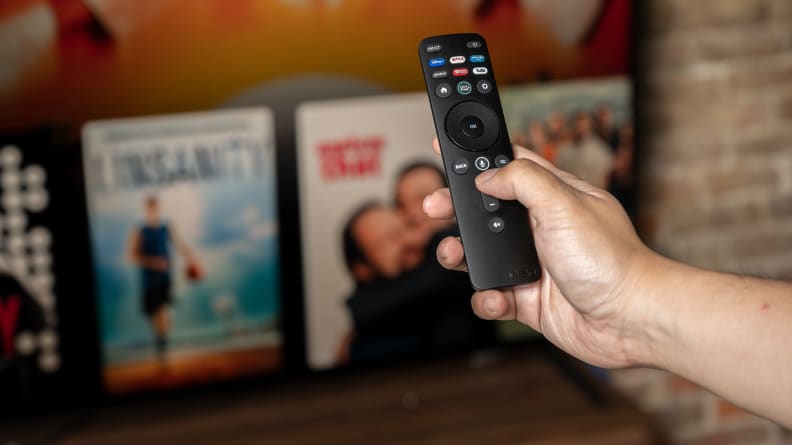
There's still plenty to love here.
Maybe, if you want a big and bright TV for gaming
The Vizio P-Series Quantum X should be lauded for its relative affordability. While most new, kitted-out TVs in this size cost upwards of $4,000, the PQX gives you a taste of the high-end, enormous-TV lifestyle for significantly less.
Its biggest drawbacks (lifted black levels during bright content, narrow viewing angles, and excessive light bloom) can only be addressed by buying a better 85-inch TV. You’ll have to spend more money on a new, superior 85-inch TV from 2022 (like the Samsung QN90B), but the excellent 85-inch version of the 2021 Samsung QN90A, for example, is currently on sale for about $2,600. From contrast to viewing angle, the QN90A’s display hardware delivers better performance than the PQX. (Note, however, that the QN90A is only carrying one HDMI port capable of 4K gaming at 120fps.)
Alternatively, if you’ve already made peace with some potential performance drawbacks and want to spend even less on an 85-inch TV, you’ve got some options. The all-new Samsung Q60B is available in an 85-inch model, and right now it’s priced at around $2,000. The Q60B doesn’t get anywhere near as bright as the PQX and will suffer from similar off-axis viewing issues, but you’ll pocket a pretty big wad of cash and still get the benefits of quantum dots.
And, while we’ve not tested the 85-inch TCL XL 4-Series, this TV can be found on sale right now for $1,300 to $1,600 dollars. Of all the 85-inch TVs we’ve discussed, this one is definitely the dimmest, as it doesn’t come with quantum dots or fancy display hardware. Still, it's a remarkably cheap 85-inch TV that comes with our favorite smart platform (Roku) built right in.
The Vizio P-Series Quantum X is a fine TV, and one of the most affordable ways to secure top-tier brightness and next-gen gaming features in this size bracket. If you’ve been searching for a big, bright, gamer-friendly LED TV for a sunny room—and perhaps for a way to save a bit of money in the process—the PQX is a solid contender. But if you want the best possible performance in this size bracket and next-gen gaming features, you’ll have to get creative by either spending more for something new or spending a bit less for something older.
Meet the tester
Michael Desjardin graduated from Emerson College after having studied media production and screenwriting. He specializes in tech for Reviewed, but also loves film criticism, weird ambient music, cooking, and food in general.
Checking our work.
Our team is here to help you buy the best stuff and love what you own. Our writers, editors, and experts obsess over the products we cover to make sure you're confident and satisfied. Have a different opinion about something we recommend? Email us and we'll compare notes.
Shoot us an email